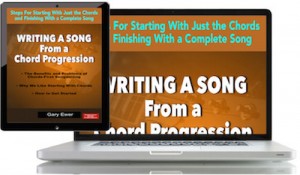In pop songwriting, the word hook is often used synonymously with chorus. “I’ve just written a hook” usually means that you’ve got the main part of your chorus done. But in fact, that concept we call the hook is more complex, and overlaps with other elements we typically call riffs, motifs, maybe even loops and other types of repetitive patterns.
So if you’ve only ever considered that a hook is something that happens in the chorus (or indeed might actually be the chorus), you’re probably missing out on the great potential for this important component of popular songwriting.
In fact, the following is usually true for most songs:
- A hook can appear anywhere in a song.
- Songs can use several hooks, and often do.
- Hooks can be layered in a hierarchical kind of way.
To give it a concise definition, you might say that a hook is a short, catchy fragment of music that has an interesting melodic shape, a captivating rhythm, and a short, tonally strong chord progression.
 “Hooks and Riffs: How They Grab Attention, Make Songs Memorable, and Build Your Fan Base” is part of “The Essential Secrets of Songwriting” 10-eBook Deluxe Bundle. It shows how and why good hooks have turned songs into winners, and gives you 3 quick methods for creating your own song hooks.
“Hooks and Riffs: How They Grab Attention, Make Songs Memorable, and Build Your Fan Base” is part of “The Essential Secrets of Songwriting” 10-eBook Deluxe Bundle. It shows how and why good hooks have turned songs into winners, and gives you 3 quick methods for creating your own song hooks.
Here are some tips for getting the most out of the potential power of a song hook:
- Chorus Hook: Think Carefully About the Rhythm of the Words. A chorus hook will often make the song’s title a central point of focus. “Born in the U.S.A”, “Billie Jean”, “Happy”, “Rumour Has It”… these are all great chorus hooks where the rhythm of the words are possibly the most enticing part. They often involve some sort of syncopation (displaced beat) that make the words pop.
- Intro Hook: Grab Attention Right Away. A good intro hook makes it hard to turn the song off. There’s no build up here – an intro hook will wave an immediate flag and get listeners hooked. It can be simple, like the guitar in The Rolling Stones’ “Satisfaction“, or something more complex and riff-like, perhaps like Dire Straits’ “Money For Nothing.”
- Instrumental Hook: It’s a Groove. Something in the intro can continue through the song, forming the foundation for everything that happens. It usually comes across as a kind of groove, like the clavinet in Stevie Wonder’s “Superstition”. With an instrumental hook, the rhythm and chords form the most important components, with the melodic feature often taking a back seat to stay out of the way of any other eventual melodies.
- A Sound Effect Hook: Short & Sweet: Back in the 60s, audiences were amused but entranced by that quirky voice on The Champ’s “Tequila.” A good sound effect hook pulls listeners in with a very short, often unexpected word or other effect. It often adds to the fun factor of the song, but doesn’t need to sound weird, as we notice with The Lumineers’ “Ho Hey.“
- Hooks Can Be Layered. The Champs’ “Tequila” is a good example of this. You get a catchy rhythmic riff that starts the song, and it’s a hook in the sense that it’s short, repetitive, built over a simple chord progression. The sax plays what could easily be thought of as a strong melodic hook, and then you get the spoken word “tequila”. Several hooks, some stronger than others, all layered together to produce a hit song.
Writing a hook is something that can get in the way of your natural songwriting process if you allow the notion to be something over which you obsess. The best hooks feel easy and natural. Remember that songs include many elements, and though a good hook will often grab the most attention, other components such as a strong melody and clever lyric will be every bit as (or possibly more) important in the long run than whatever hook you might come up with.
But if you consider nothing else, remember that most songs contain several elements that can be thought of as hooks, and the best songwriters are the ones that layer them together in the most effective way.
 Written by Gary Ewer. Follow Gary on Twitter
Written by Gary Ewer. Follow Gary on Twitter
 “Writing A Song From a Chord Progression” is a manual specifically meant for chords-first songwriters. It gives you a powerful step-by-step procedure that will take you from chords to completed song. It’s part of “The Essential Secrets of Songwriting” 10-eBook Deluxe Bundle. GET THE DISCOUNT PRICE. READ MORE..
“Writing A Song From a Chord Progression” is a manual specifically meant for chords-first songwriters. It gives you a powerful step-by-step procedure that will take you from chords to completed song. It’s part of “The Essential Secrets of Songwriting” 10-eBook Deluxe Bundle. GET THE DISCOUNT PRICE. READ MORE..











The part that HOOKS you in as Gary States, that can be anywhere in
the song ; Pretty Woman ( Orbison) The strongest hook in the song
is the guitar lead intro We have played that opening riff on stage and fifty
people have rushed onto The Dance Floor it’s infectious and why ???
It is totally original It starts of with one 4/4 Bar then it’s followed by one 2/4
bar before returning to Common time.
There is a reason behind that ,Try making the second bar 4/4 , and it
makes the riff boring Two beats Too boring
That was clever of the co writer Roy Orbison, Roy wrote all of his songs
via guitar chords and Hooks and he often slipped in a 2/4 Bar it made his
work unique